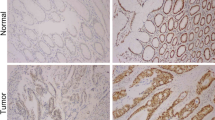Abstract
Purpose
The POU5F1 gene, which encodes the POU domain, class 5, transcription factor 1 (also known as Oct-4), is expressed in embryonic stem cells where it regulates pluripotency and proliferation. Few studies have examined the expression and significance of POU5F1 in cancer tissues. The aim of this study was to clarify its significance in colorectal cancer (CRC).
Methods
The study included 95 patients who underwent surgery for CRC from 2009 to 2011. The correlations between the POU5F1 gene expression and the clinical parameters were assessed in these patients. The serum TP53 expression levels were also examined by an enzyme-linked immunosorbent assay.
Results
Patients with a high POU5F1 expression were significantly more likely to have a poor prognosis than those with a low expression. In contrast, patients with a low POU5F1 expression had a better disease-free survival after curative surgical resection than those with a high expression (P = 0.007). Multivariate analyses showed that the POU5F1 expression (P = 0.003) and lymph node metastasis (P < 0.001) were significantly correlated with the disease-free survival. The prognosis was significantly related to the serum TP53 levels, according to the POU5F1 expression.
Conclusion
The POU5F1 expression was suggested to be a prognostic factor in patients with CRC.




Similar content being viewed by others
References
Siegel R, Ma J, Zou Z, Jemal A. Cancer statistics, 2014. CA Cancer J Clin. 2014;64:9–29.
Stein U, Schlag PM. Clinical, biological, and molecular aspects of metastasis in colorectal cancer. Recent Results Cancer Res. 2007;176:61–80.
Watanabe T, Itabashi M, Shimada Y, Tanaka S, Ito Y, Ajioka Y, et al. Japanese Society for Cancer of the Colon and Rectum (JSCCR) guidelines 2014 for the treatment of colorectal cancer. Int J Clin Oncol. 2015;20:207–39.
Colvin H, Mizushima T, Eguchi H, Takiguchi S, Doki Y, Mori M. Gastroenterological surgery in Japan: The past, the present and the future. Ann Gastroenterol Surg. 2017;1:5–10.
Scholer HR, Dressler GR, Balling R, Rohdewohld H, Gruss P. Oct-4: a germline-specific transcription factor mapping to the mouse t-complex. EMBO J. 1990;9:2185–95.
Loh YH, Wu Q, Chew JL, Vega VB, Zhang W, Chen X, et al. The Oct4 and Nanog transcription network regulates pluripotency in mouse embryonic stem cells. Nat Genet. 2006;38:431–40.
Cai S, Geng S, Jin F, Liu J, Qu C, Chen B. POU5F1/Oct-4 expression in breast cancer tissue is significantly associated with non-sentinel lymph node metastasis. BMC Cancer. 2016;16:175.
Sobin LH, Gospodarowicz MK. TNM Classification of Malignant Tumors, seventh edition (2009) Union Internationale Contre le Cancer and the American Joint Committee on Cancer. Wiley, Hoboken, 100–9.
Niwa H, Miyazaki J, Smith AG. Quantitative expression of Oct-3/4 defines differentiation, dedifferentiation or self-renewal of ES cells. Nat Genet. 2000;24:372–6.
Miyoshi N, Stel JM, Shioda K, Qu N, Odahima J, Mitsunaga S, et al. Erasure of DNA methylation, genomic imprints, and epimutations in a primordial germ-cell model derived from mouse pluripotent stem cells. Proc Natl Acad Sci USA. 2016;113:9545–50.
Miyoshi N, Ishii H, Nagai K, Hoshino H, Mimori K, Tanaka F, et al. Defined factors induce reprogramming of gastrointestinal cancer cells. Proc Natl Acad Sci USA. 2010;107:40–5.
Liu CG, Lu Y, Wang BB, Zhang YJ, Zhang RS, Lu Y, et al. Clinical implications of stem cell gene Oct-4 expression in breast cancer. Ann Surg. 2011;253:1165–71.
Ferreyra Solari NE, Belforte FS, Canedo L, Videla-Richardson GA, Espinosa JM, Rossi M, et al. The NSL chromatin-modifying complex subunit KANSL2 regulates cancer stem-like properties in glioblastoma that contribute to tumorigenesis. Cancer Res. 2016;76:5383–894.
Andre T, Quinaux E, Louvet C, Colin P, Gamelin E, Bouche O, et al. Phase III study comparing a semimonthly with a monthly regimen of fluorouracil and leucovorin as adjuvant treatment for stage II and III colon cancer patients: final results of GERCOR C96.1. J Clin Oncol. 2007;25:3732–8.
Wolpin BM, Mayer RJ. Systemic treatment of colorectal cancer. Gastroenterology. 2008;134:1296–310.
Kornmann M, Formentini A, Ette C, Henne-Bruns D, Kron M, Sander S, et al. Prognostic factors influencing the survival of patients with colon cancer receiving adjuvant 5-FU treatment. Eur J Surg Oncol. 2008;34:1316–21.
Bathe OF, Dowden S, Sutherland F, Dixon E, Butts C, Bigam D, et al. Phase II study of neoadjuvant 5-FU + leucovorin + CPT-11 in patients with resectable liver metastases from colorectal adenocarcinoma. BMC Cancer. 2004;4:32.
Sadanandam A, Lyssiotis CA, Homicsko K, Collisson EA, Gibb WJ, Wullschleger S, et al. A colorectal cancer classification system that associates cellular phenotype and responses to therapy. Nat Med. 2013;19:619–25.
Kawamura T, Suzuki J, Wang YV, Menendez S, Morera LB, Raya A, et al. Linking the p53 tumour suppressor pathway to somatic cell reprogramming. Nature. 2009;460:1140–4.
Zhen HY, Zhou J, Wu HN, Yao C, Zhang T, Wu T, et al. Lidamycin regulates p53 expression by repressing Oct4 transcription. Biochem Biophys Res Commun. 2014;447:224–30.
Acknowledgements
We thank Ms. Aya Ito for her technical assistance.
Author information
Authors and Affiliations
Corresponding author
Ethics declarations
Conflict of interest
The authors declare that no competing financial interests exist.
Electronic supplementary material
Below is the link to the electronic supplementary material.
Rights and permissions
About this article
Cite this article
Miyoshi, N., Fujino, S., Ohue, M. et al. The POU5F1 gene expression in colorectal cancer: a novel prognostic marker. Surg Today 48, 709–715 (2018). https://doi.org/10.1007/s00595-018-1644-9
Received:
Accepted:
Published:
Issue Date:
DOI: https://doi.org/10.1007/s00595-018-1644-9




